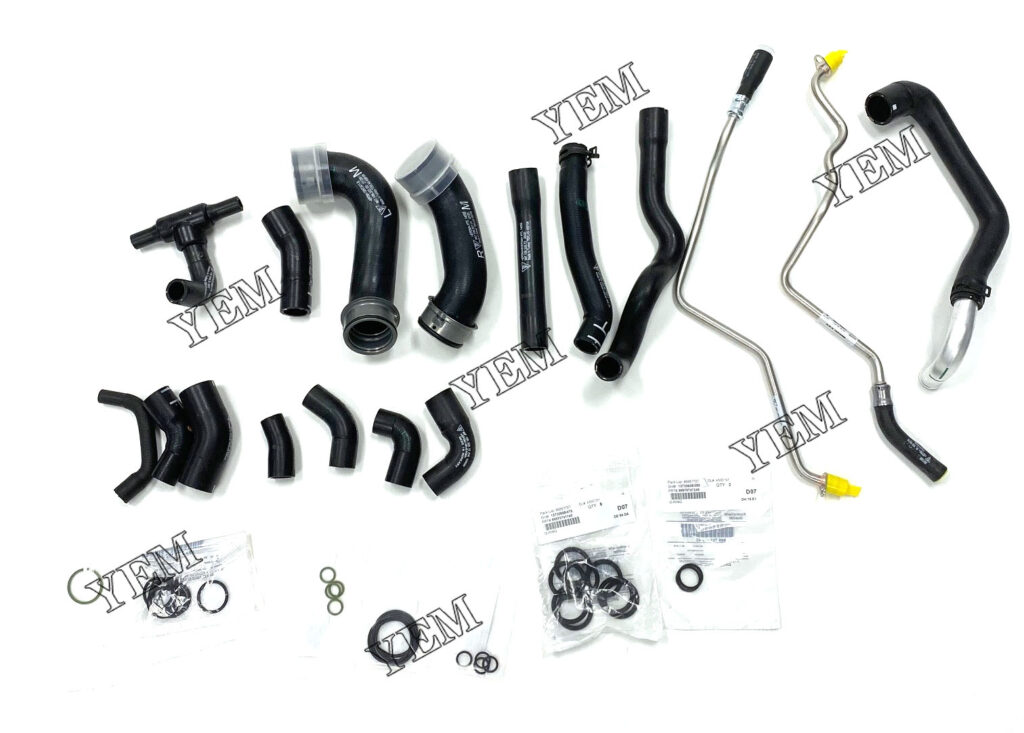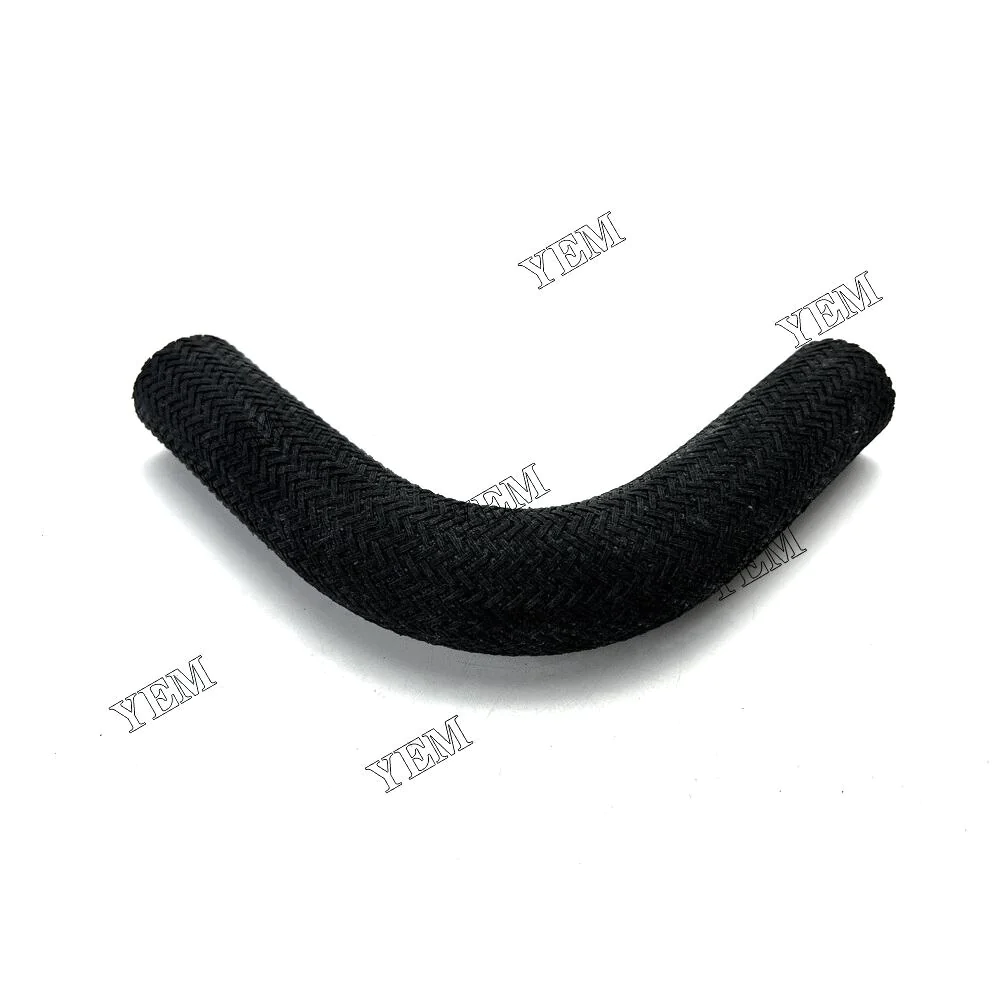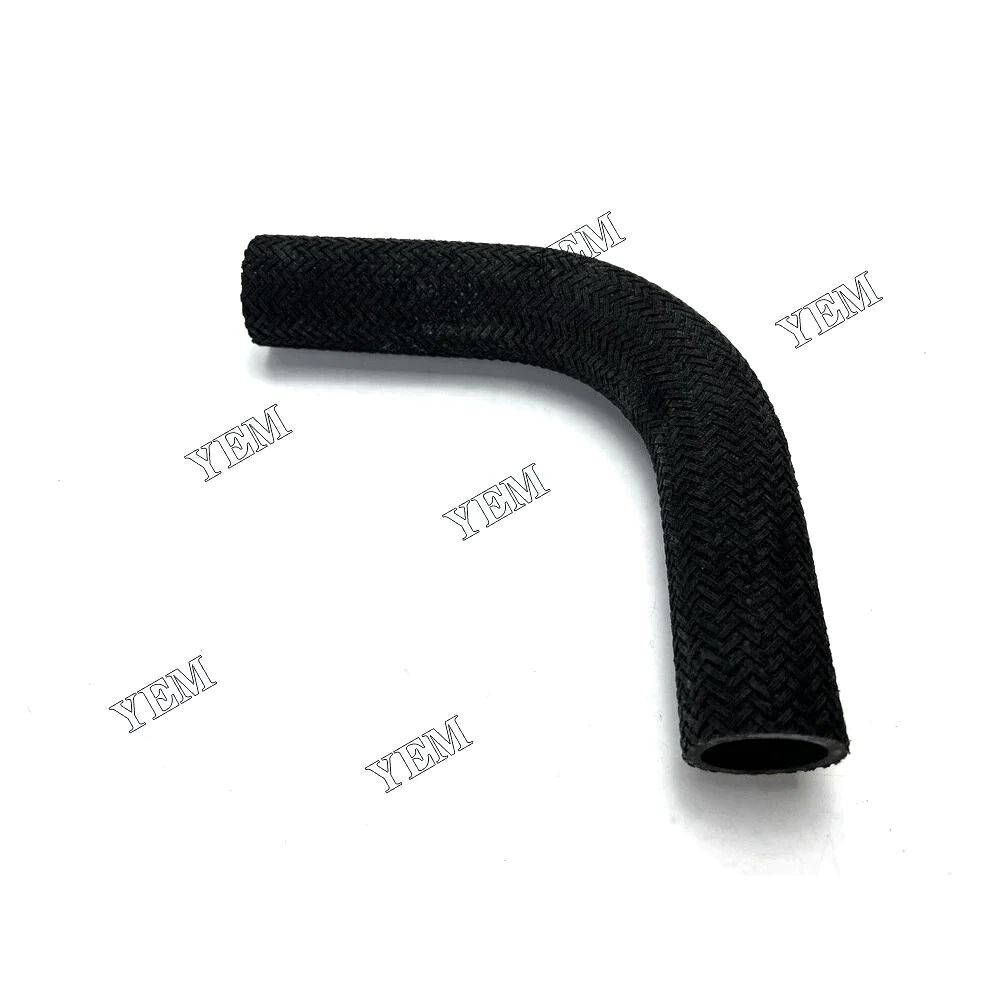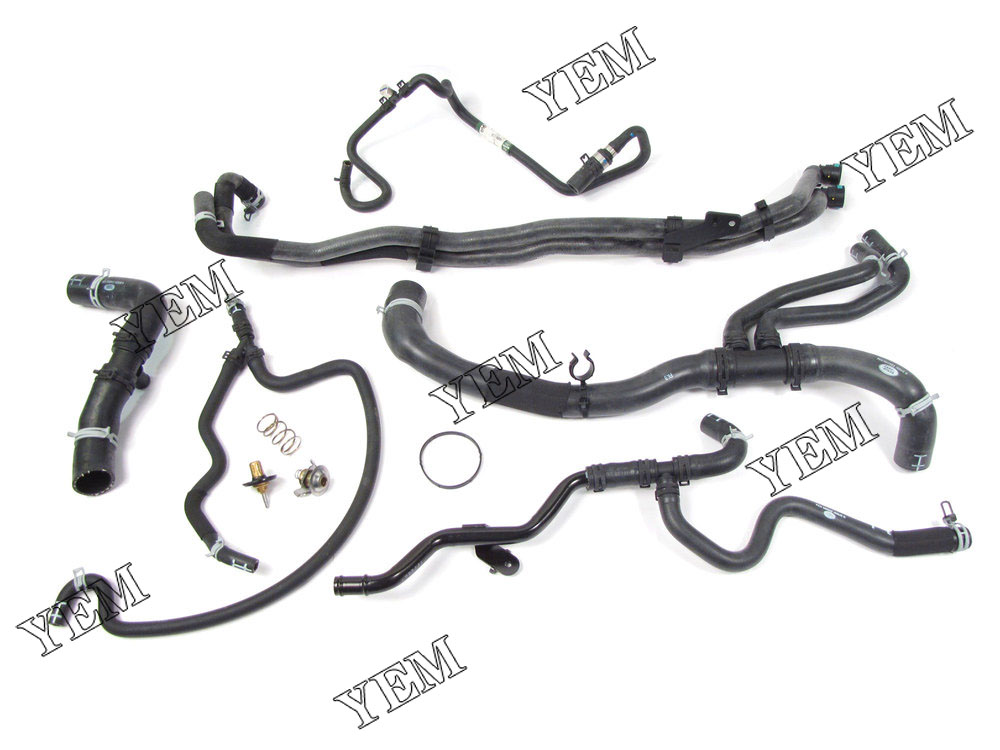The functions and functions of engine hoses
The engine hose is a piping system that connects various parts of the engine and has multiple functions and functions:
- Transmission of liquids and gases: Engine hoses are used to transmit various liquids and gases, such as cooling water, engine oil, fuel oil, hydraulic oil, air, etc., to ensure that these substances can effectively flow between different parts inside and outside the engine.
- Connect various components: Engine hoses play a role in connecting various key components inside and outside the engine, including connecting coolers, radiators, turbochargers, fuel pumps, fuel tanks, oil coolers, hydraulic systems wait.
- Provide pressure and control flow: The engine hose can provide the required pressure and control flow through the internal design and material characteristics of the pipeline, so as to ensure that liquid and gas can flow at an appropriate speed to meet the requirements of engine operation.
- Cooling and heat dissipation: The cooling water pipes and oil cooling pipes in the engine hoses can cool and dissipate engine components by transferring cooling medium to prevent overheating and damage.
- Anti-vibration and shock absorption: When the engine is running, it will generate vibration and shock. The engine hose can absorb and slow down these vibrations and shocks, and protect the engine components from damage.
- Prevent leakage and pollution: The engine hose adopts sealing design and material, which can reduce the risk of leakage, prevent the leakage of liquid or gas and pollute the environment.
In general, engine hoses play an important role in the operation of the engine, ensuring the transmission and control of various liquids and gases, connecting various components, providing pressure and cooling, while being able to absorb shock, prevent leakage and pollution, and improve the performance of the engine and reliability.

Types of engine hoses
There are many types of engine hoses, which can be divided into the following categories according to their functions and uses:
- Cooling water pipe: used to transmit the coolant (such as water or coolant) in the engine cooling system, and realize the cooling and heat dissipation of the engine by connecting the engine and radiator and other components.
- Fuel pipe: used to transmit fuel to the engine combustion chamber, including the main fuel pipe for supplying fuel and the return pipe for returning fuel to ensure fuel supply and circulation.
- Hydraulic pipes: used to transmit hydraulic oil and supply hydraulic components and actuators in the hydraulic system, such as hydraulic pumps, hydraulic cylinders, hydraulic valves, etc.
- Air pipe: used to transport air, such as an intake pipe, connected to the intake system of the engine, and introduces air into the engine for combustion.
- Exhaust pipe: used to discharge the exhaust gas after combustion, and discharge the exhaust gas from the engine to the atmosphere, including exhaust manifolds, exhaust pipes and other parts.
- Liquid transmission pipes: In addition to the above-mentioned pipes, there are also some engine hoses with specific functions, which are used to transmit other liquids, such as oil pipes, coolant pipes, etc.
From a material point of view, engine hoses are usually made of rubber, metal, polymer composites or fiber-reinforced materials. Hoses of different materials have different characteristics and performance, and are suitable for different working environments and fluid transmission requirements.
It should be noted that different brands and models of engine hoses may have slight differences to suit different engine designs and application needs. Therefore, when selecting and replacing hoses, use hoses that meet the specifications and certifications according to the specific engine model and requirements.
Engine hose manufacturing materials
The manufacturing materials of engine hoses usually include the following:
- Rubber: Rubber is one of the most commonly used engine hose materials, with good elasticity and sealing performance. Common rubber materials include styrene-butadiene rubber (NBR), chloroprene rubber (CR), ethylene-propylene rubber (EPM), fluororubber (FKM), etc. Different types of rubber materials have different chemical resistance, heat resistance and abrasion resistance, and are suitable for different working environments and fluid transmission requirements.
- Metal: Metal hoses are usually made of metal materials such as stainless steel and aluminum alloy, which have high pressure resistance and heat resistance. Metal hoses are widely used in high-temperature, high-pressure liquid and gas transmission, such as turbochargers, hydraulic systems, etc.
- Polymer composite material: A polymer composite material is a composite material composed of a fiber reinforcement and a resin matrix. These composite materials generally have high strength, stiffness and chemical resistance, and are suitable for special service hose applications. Commonly used polymer composite materials include polyamide, polyimide, carbon fiber reinforced materials, etc.
- Fiber reinforcement: Fiber reinforcement is often combined with rubber or polymer composites to provide additional strength and stiffness. Common fiber reinforced materials include glass fiber, carbon fiber, aramid fiber, etc. These materials can enhance the wear resistance, tensile strength and pressure resistance of the hose in the manufacture of the hose.

The material from which engine hoses are made will be selected based on factors such as specific fluid transfer requirements, operating environment and temperature. When selecting hose materials, factors such as heat resistance, chemical resistance, abrasion resistance, sealing, and compatibility with conveying liquids or gases need to be considered to ensure the safety and reliability of the hose. In addition, hoses may also need to comply with specific certification and regulatory requirements according to the relevant standards of different countries and industries.
Engine hose maintenance and care
Engine hose maintenance and care is critical to keeping your engine in good working order. Here are some common engine hose care and maintenance recommendations:
- Periodic Inspection: Regularly inspect the appearance and connections of the engine hoses, looking for any obvious signs of wear, cracks, leaks or other damage. Make sure the hose is not loose or poorly secured.
- Cleaning: Keep the engine hoses clean and clean them regularly with mild soapy water or detergent. Avoid cleaning agents such as strong acids, alkalis or organic solvents that may damage the hose material.
- Pay attention to the temperature: Avoid exposing the engine hose to excessively high temperature, which may cause the hose to age, harden or expand, resulting in leakage or rupture. Make sure hoses are kept a proper distance from hot parts and protected from heat with insulation.
- Periodic Replacement: Periodically replace engine hoses according to the manufacturer’s recommendations or as required by the maintenance manual to prevent problems caused by obsolescence, aging or wear. Note the mileage, hours or intervals between hose changes.
- Avoid excessive bending: Avoid excessive bending of the engine hose, excessive bending may cause pressure concentration inside the hose and increase the risk of rupture. Make sure the hose is installed and connected with an adequate bend radius to avoid excessive twisting or stretching.
- Prevent contamination and damage: Avoid contact of engine hoses with harmful substances such as chemicals, fuel oil, grease, etc., which may cause damage to hose materials. Also, avoid contact of the hose with sharp objects or sharp edges to prevent cutting or damaging the hose.
- Follow manufacturer’s recommendations: Strictly follow the engine manufacturer’s recommendations and instructions, including hose replacement intervals, specific hose types and sizes used, methods of installation and connections, etc.
The above are some common engine hose maintenance and maintenance suggestions. Regular inspection, cleaning and replacement of hoses, as well as avoiding excessive bending and improper use, can prolong the service life of the hoses and ensure the safe and reliable operation of the engine. If you find any problems or suspect that the hose is damaged, please contact professional maintenance personnel in time.
Troubleshooting engine hoses
When engine hoses fail, there are several common failures that can cause the hose to fail or not function properly. Here are some possible troubleshooting methods:
- Leaks: If you find a leak in the hose, you first need to determine where the leak is. You can use a paper towel or cleaning cloth to wipe the surface of the hose to see if there is any liquid seeping. If leaks are found, the hoses need to be checked for loose connections or damaged seals. Depending on the situation, it may be necessary to retighten the connection or replace the sealing gasket, etc.
- Cracks or abrasions: Long-term use or misuse of the hose may cause cracks or abrasions. The hose can be inspected visually, looking for any obvious cracks or signs of wear. If cracks or wear are found, the hose may need to be replaced. Take care to determine the model and specification of the hose, and be sure to select a replacement hose that meets the requirements.
- Damage or cracking: The hose may be subject to external pressure, vibration or impact from other objects during operation, resulting in damage or cracking of the hose. If you find obvious damage or cracks in the hose, the hose may need to be replaced immediately to prevent leaks or other failures.
- Bending or Kinking: The hose may be excessively bent or kinked during use due to improper installation or operation. This may prevent fluid flow inside the hose or increase the risk of hose wear. If you find that the hose is bent or kinked, make adjustments to ensure the hose is in the proper position and angle.
- Aging or hardening: The hose may harden due to material aging or being affected by high temperature, chemical substances and other factors during long-term use. If the hose becomes stiff or shows signs of age, the hose may have lost its elasticity and needs to be replaced.

Note that the above troubleshooting methods are for reference only, and specific troubleshooting steps may vary depending on hose type, vehicle model, etc. If you are unsure or unable to solve the problem, please consult a professional auto repair technician or related repair guide to ensure safe and correct troubleshooting.
Application examples of engine hoses
Engine hoses are used in many ways, the following are some common engine hose application cases:
- Cooling system hose: The cooling system hose is used to carry coolant from the engine water pump to the radiator, and from the radiator back to the engine. These hoses help maintain the engine’s temperature within normal limits to prevent overheating and damage.
- Fuel system hose: The fuel system hose is used to transfer fuel from the fuel tank to the engine fuel injectors or fuel pump. These hoses ensure the reliability and fluidity of the fuel supply for engine combustion and performance.
- Exhaust System Hoses: Exhaust system hoses are used to direct combustion exhaust gases from the engine and into the atmosphere. These hoses are usually connected to exhaust manifolds, exhaust pipes and mufflers to effectively control exhaust emissions and noise levels.
- Air intake system hose: The air intake system hose is used to direct air to the engine’s intake system for combustion. These hoses are usually attached to components such as air intakes, air filters and intake manifolds.
- Hydraulic system hoses: Hydraulic system hoses are used to transmit hydraulic oil for hydraulic components and actuators in the hydraulic system. These hoses are usually connected to hydraulic pumps, hydraulic cylinders, hydraulic valves and other components.
These are just some examples of engine hose applications, in fact, engine hoses are widely used in automobiles, ships, aircraft and other various engine driven equipment. These hoses play an important role in transferring media, connecting different components and keeping systems running properly by conveying liquids, gases and pressure. The design and selection of hoses need to be reasonably selected according to specific application requirements, including temperature, pressure, chemical properties and other factors.

Development trends of engine hoses
The development trend of engine hoses mainly focuses on the following aspects:
- High temperature and high pressure applications: With the continuous development of engine technology, the temperature and pressure requirements for hoses are also getting higher and higher. Future engine hoses will need to have better resistance to high temperature and high pressure to accommodate more complex engine systems.
- Lightweight design: The weight requirements in fields such as automotive and aerospace are becoming more and more stringent. Therefore, engine hoses tend to be lightweight in design and material selection, using high-performance materials and composite materials to reduce weight, improve fuel economy and reduce emissions.
- Application of high-performance materials: With the advancement of material science, the application of a new generation of high-performance materials will promote the development of engine hoses. For example, high-temperature-resistant ceramic composite materials, high-strength and low-density carbon fiber-reinforced composite materials, etc., will provide higher durability and reliability.
- Integrated sensor technology: With the development of intelligence and the Internet, engine hoses may integrate sensor technology to monitor the status and working performance of the hose. This will make the maintenance of the hose more accurate and timely, and improve the reliability and safety of the engine.
- Environmental protection performance: The continuous improvement of global environmental protection and emission standards will promote the design of engine hoses to develop in a more environmentally friendly direction. For example, developing more environmentally friendly rubber materials, reducing volatile organic compound (VOC) emissions, etc., to reduce the negative impact on the environment.
- Predictive maintenance and intelligent monitoring: use technologies such as the Internet of Things, big data, and artificial intelligence to connect engine hoses with vehicle systems, and realize predictive maintenance and intelligent monitoring. By tracking the working parameters and health status of the hose in real time, the life and failure risk of the hose can be predicted, and maintenance or replacement measures can be taken in advance.
To sum up, the development trends of engine hoses include high temperature and high pressure resistance, lightweight design, application of high-performance materials, integrated sensing technology, environmental performance, and intelligent monitoring and predictive maintenance. These trends will drive the continuous advancement of hose technology to meet the needs and requirements of future engine systems.
Contact us
YEM Excavator Parts Co., Ltd. is a company specializing in the research, development, production and sales of excavator parts. We are committed to providing high-quality, high-performance excavator accessories solutions to global customers.
As a professional company, we have an experienced and skilled R&D team, capable of continuous research and innovation, and design and develop excavator accessories products that meet market demand. We pay attention to product quality control, adopt advanced production technology and equipment to ensure that each product can meet international standards and pass strict quality inspections.
Our product range covers all kinds of excavator accessories, including hydraulic cylinders, oil seals, filters, cabs, etc. These accessories have been carefully selected and designed to ensure compatibility with a wide range of excavators and to maintain outstanding performance and reliability in harsh operating environments.
We not only provide existing excavator accessories, but also customize design and production according to customer needs. Whether it is standard parts or non-standard parts, we can precisely manufacture and provide high-quality solutions according to the requirements provided by customers.
Our company not only pays attention to product quality, but also attaches great importance to customer service. We have a professional customer service team that can answer customer inquiries and solve customer problems in a timely manner. We also provide installation, maintenance and after-sales service of accessories to ensure that customers can get all-round support and assistance.
